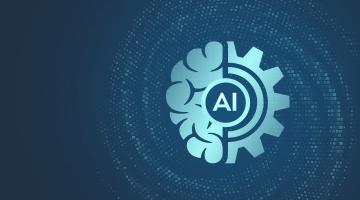
AI in financial modeling: Use cases and key benefits
The contemporary financial industry is a high-risk sector where every decision is fraught with grave consequences that may result in prodigious revenues or—God forbid—exorbitant monetary losses. Trying to maximize profits and avoid damage, financial analysts explore a large amount of market data, examine multiple economic indicators, and follow dynamic market conditions to manage risks and accomplish prudent financial planning.
The rapid growth of customer and financial data volumes has turned traditional financial forecasting methods into inadequate and cumbersome procedures that can’t live up to the call of the times. Obsolete and time-consuming routines of interpreting transaction data in Microsoft Excel tables conducted by human analysts are intensely replaced by robust data processing practices leveraged by AI systems, allowing for more accurate predictions and data-driven decision-making.
In this article, we will define financial modeling, asses the role artificial intelligence can play for predictive analytics in this field, consider the benefits and use cases of fintech AI models, enumerate the challenges AI integration should address, and outline prospects of harnessing AI-powered tools for financial model building.
Need to build a custom fintech solution? Check out our fintech software development services.
Financial modeling made plain
In finance, modeling is the major instrument for proactive risk management and strategic decision-making. It involves creating a summary of an organization’s earnings and expenditures, which serves as a guideline for possible scenario analysis related to future decisions, events, cash flows, etc.
Classical financial models rely on historical data spreadsheets created via manual data input and calculation logic applied to multiple data points. The latter have to be checked for errors, and every model should be built from scratch. Moreover, conventional models are notorious for their static nature, failing to capture recent developments, real-time changes, and fluctuating market trends. Their predictive power is limited because they utilize simple business logic and elementary extrapolation methods. Report generation, system updating, and model adjustments must be handled manually.
Evidently, traditional financial modeling approaches fall utterly short of finance professionals’ expectations, urging them to harness AI-driven models for this purpose.
Related article: How to build a fintech app: Types, stages, and requirements
Why is AI financial modeling beneficial for financial organizations?
AI technology has become a godsend for financial institutions whose long-term strategic planning and financial decision-making were hamstrung by the inadequacy of old-school approaches. AI addresses all issues related to slow and effort-consuming data entry, analyzing vast datasets, generating real-time insights, effective management of complex variables, and other bottlenecks traditional financial models can’t tackle.
AI-driven models are flexible and scalable tools based on large language models that quickly and meticulously process input assumptions and large datasets drawn from various sources, take into account different scenarios of events and financial operations’ consequences, and produce accurate predictions. Such forecasts remain relevant for a long time since they are constantly updated and amplified by ingesting fresh data in real-time. Machine learning models that fuel such software enable its continuous sophistication and ongoing learning of AI algorithms that use analyzed information as training data.
What benefits does implementing AI-powered financial modeling bring to finance, banking, and investment sector enterprises?
Read a related article on the topic “Artificial intelligence in finance: Top advantages and use cases”
Assets of AI-driven financial modeling showcased
Integrating AI solutions honed for financial modeling ushers in the following perks for organizations in the domain.

- Increased accuracy. Thanks to AI models and advanced algorithms, the accuracy of calculations and predictions grows manifold. Moreover, financial analysis precision is enhanced as AI-powered review tools consider numerous complex factors and learn in the process of functioning.
- Automated and streamlined workflows. Data entry, cleansing, model building, and financial reporting become faster and more efficient. The same applies to predictive analytics tasks, which are essentially facilitated after AI implementation.
- Error reduction. Fat-fingering, oversights, incompetence, and other human factors that adversely impact the quality of analysis are eliminated. AI works tirelessly and flawlessly, yielding error-free results hand over fist.
- Facilitated data volume management. Forget about dataset size limits conditioned by the capacities of spreadsheets. Artificial intelligence can import, organize, and process any amount of data without the need to deliver them to a spreadsheet.
- Scalability and flexibility. AI-based financial models can be easily scaled up or down, depending on the need to handle greater or smaller data quantities. They can also be adjusted to work with different scenarios, data sources, and variables.
- Superb integration potential. All AI-powered systems (including financial models) play well with each other or any disruptive technologies necessary for the efficient execution of multiple financial operations.
- Augmented collaboration possibilities. Since AI software is cloud-based, it rules out potential data silos threats and enables access of all stakeholders, thus providing broad opportunities for coordination of effort and agile cooperation of personnel across the entire organization.
- Continuous learning. ML-driven solutions augment the accuracy of their performance with each new dataset update, improving the quality of insights they generate.
- Low onboarding barrier. Natural language processing mechanisms that form the core of AI-powered financial models allow machines to understand commands and queries given in simple human language. This means you won’t need a skilled financial analyst or data expert to leverage these models, but you can delegate this task to an employee with any (even non-tech) background.
- Cost and time efficiency. Despite the need for initial investment in AI financial model development, companies embracing the technology stand to benefit in the long run. They can save on high expenditures covering manual labor utilization and usher in the digital transformation of their workflows, which translates into greater efficiency, increased workforce productivity, and a sharper competitive edge.
What are the areas of the financial pipeline where AI-driven modeling solutions bring the most value?
Zooming in on AI financial modeling use cases
As a seasoned IT vendor who knows the ins and outs of fintech organizations’ shop floor routine, DICEUS envisions the following spheres of the technology’s application in the niche.

Data processing and analysis
AI’s ability to handle vast datasets makes it a perfect tool for analyzing historical data, market records, news sentiment, and other similar data to detect patterns, anomalies, and trends.
Financial reporting
Thanks to AI’s advanced automation features, employees can create financial statements much faster and avoid errors that usually creep into such complex documents if they are written by humans.
Predictive analytics
Accurate forecasts provided by AI mechanisms are the key to optimizing investment strategies, wealth management, revenue prediction, and other future-oriented financial tasks that lay the reliable foundation for planning and decision-making.
Risk assessment
With the power of AI, financial models augment their capabilities for evaluating credit, operational, private equity, and other risks, which allows companies to launch early warning systems, adopt proactive preventive measures, and mitigate potential losses.
Fraud detection
The financial sector is a constant target for fraudsters who try to exploit organizations’ inadequate protection mechanisms. AI-driven financial modeling systems can identify anomalies and suspicious activities in analyzed transaction data and red-flag them.
Scenario and sensitivity analysis
While performing these tasks, AI algorithms swiftly adjust major variables, evaluate the impact of changes, assess potential outcomes, pinpoint opportunities, and offer mitigation strategies if any risks are detected.
Budgeting and wealth management
The revenue, expense, and cash flow patterns discovered by AI models allow for more precise budget calculation (for individuals and organizations), efficient resource allocation, and anticipation of financial needs. When integrated with robo-advisers, AI models provide personalized financial advice based on the in-depth evaluation of clients’ profiles and individual goals.
Credit and loan analysis
AI models excel at accurately assessing borrowers’ creditworthiness and creating detailed risk profiles. As a result, banks can customize their credit lines and loan terms and optimize their approval workflow.
Tax planning
AI-fueled financial modeling provides companies with accurate forecasts concerning tax liabilities and analyzes the tax implications of various business operations. By keeping abreast of changes in tax regulations, AI can minimize tax burdens and reveal tax-saving opportunities.
Portfolio optimization and investment analysis
With AI’s participation, portfolio customization and calibration become a breeze. Its algorithms make tailored conclusions based on specific investment goals, stock performance, current market landscape, and the investor’s risk tolerance to offer the most efficient financial strategy for maximizing revenues and minimizing related risks.
Sounds impressive, doesn’t it? Well, it does. However, you should always watch out for pitfalls when you implement AI financial modeling.
Top challenges of harnessing AI-based financial modeling
Our experts in AI consulting recommend financial organizations pay attention to the following barriers to embracing AI models.

- Data availability and quality. If AI algorithms are limited in their access to relevant data or the records fed into them are incomplete, inaccurate, inconsistent, and hard to comprehend, the models AI builds will fail to solve business tasks.
- Market unpredictability. Finance is a highly dynamic realm prone to sudden changes, sentiment shifts, and black swan events. It is challenging for AI models to predict these or include them in calculations.
- Model validation. One of the core instruments for validating AI models is backtesting, which checks their performance against historical data. Yet, as financial markets progress, past data becomes ever less relevant, making backtested models inadequate in real-world scenarios.
- Human-AI collaboration. Sometimes, financial analysts struggle with understanding and interpreting decisions offered by AI-powered models. Or, personnel relies too much on AI’s predictions, ignoring human judgment and experience.
- Ethical issues. The robust advent of AI into multiple industries raises concerns related to its ethical employment. The developers and users of AI financial models should ensure data security both in transit and at rest, provide the AI algorithm’s accountability and transparency of functioning, and avoid unfairness and bias while training them.
- Regulatory compliance. Sensitive data protection is not only financial institutions’ obligation but also a legal requirement. Banks must constantly monitor their compliance with CCPA, GDPR, and other statutory norms and conduct regular compliance audits of AI-driven software they employ.
When organizations learn to handle these and many other problems, they can confidently face the future.
Experiencing a lack of technical expertise and skills?
Connect with a professional team to address your project challenges.
The future of AI in financial modeling
The rapidly evolving landscape of AI financial modeling is likely to bring the two basic trends to the limelight.

- Explainable AI (XAI). Specialists in the field will be focused on providing greater transparency and interpretability of AI models, and XAI best practices are called to build trust among investors and customers.
- Responsible AI. Risk assessment, loan approval, and other client-facing shop floor operations are subject to potential discrimination if AI models providing recommendations are unfair or biased. Thus, more attention will be paid to mitigating unintended consequences and maintaining human control over AI’s decisions.
As you see, the development and application of AI for financial modeling is a complex task with numerous niceties that should be entrusted to competent professionals in the niche. Vetted mavens of DICEUS have the necessary qualifications and experience to handle AI projects in the financial domain and deliver high-end products. Contact us to elevate the efficiency of your financial institution to a new level with the power of artificial intelligence.
Summing it up
In finance, modeling is employed to create a summary of a company’s revenues and expenditures that serves as a source of insights related to future business decisions, trends, and events. Artificial intelligence is dramatically transforming financial modeling into a flexible and scalable tool with a low mastering barrier that facilitates data management, automates enterprise workflows, increases prediction accuracy, minimizes errors, and enhances stakeholder collaboration.
Financial institutions leverage AI-powered modeling software in data processing and analysis, risk assessment, fraud detection, credit and loan analysis, tax planning, predictive analytics, portfolio optimization, and other pipeline operations.
When AI-based financial modeling solutions are developed and implemented by top-notch experts in the IT realm, they can address all challenges the technology’s onboarding poses and pave the way to responsible and explainable AI usage, bringing maximum value to organizations in the niche.
Frequently asked questions
What is financial modeling?
It is the process of creating spreadsheets that contain a rundown of a financial institution’s earnings and spendings. Such documents and reports are used for strategic planning and data-driven decision-making since they are honed to anticipate the impact of future developments and trends on the company’s business prospects and revenue stream.
What role does AI play in financial modeling?
Traditional financial modeling was a time- and effort-consuming ordeal that relied on manual labor to process a limited amount of data and produced short-lived insights since it couldn’t ingest new data for real-time analytics. Thanks to AI-based technologies, financial modeling enhanced the scale of its operations, being capable of analyzing huge datasets on the go and generating accurate predictions of future developments.
What are the benefits of AI for financial modeling?
AI algorithms streamline and facilitate data handling, automate the lion’s share of financial workflows, reduce human-caused errors, and enhance workforce collaboration possibilities. The software integrating AI financial models serves as a cost-efficient, scalable, and flexible fintech system that requires little specialized expertise for handling.
How does machine learning improve financial forecasting?
The key asset of machine learning algorithms is their ability to become ever more sophisticated over time by learning from new data entered into the system. As a result, ML-powered solutions improve their predictive accuracy with each data ingestion instance and can generate more precise forecasts in various areas of the financial pipeline.





